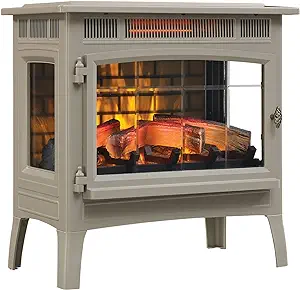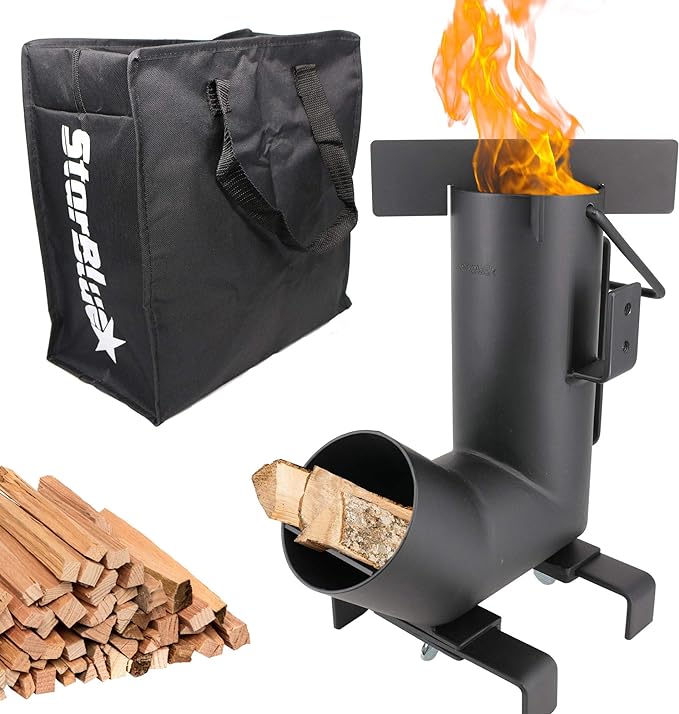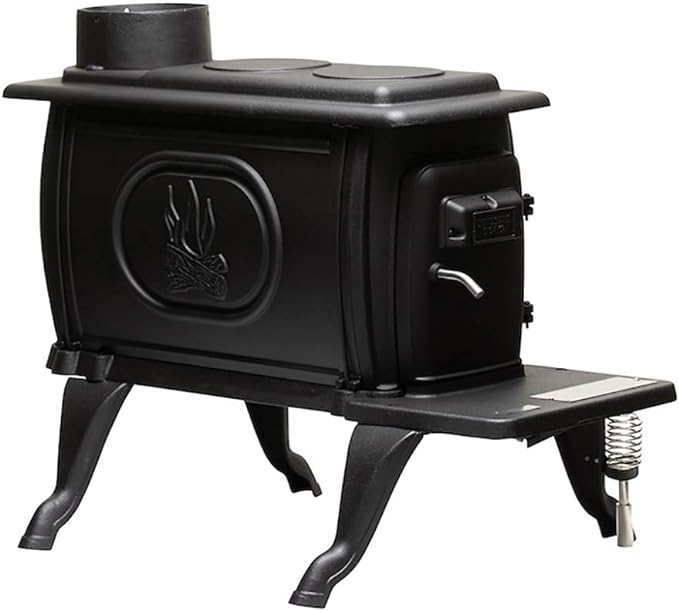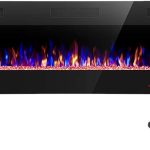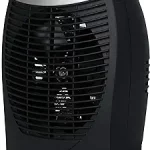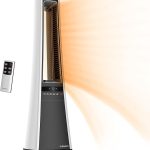You might be surprised to learn that over 70% of American households rely on wood-burning stoves as a supplemental heat source during the colder months. As you consider joining their ranks, you’re likely wondering which wood stove is right for you. With so many options on the market, it can be overwhelming. But don’t worry, you’re about to get a closer look at three top contenders: the Duraflame Electric Infrared Quartz Fireplace Stove, the StarBlue Portable Wood Burning Camping Stove, and the US Stove Company Rustic Wood Stove. Each has its unique features and benefits – and you’re about to discover what sets them apart.
Contents
Duraflame Electric Infrared Quartz Fireplace Stove
If you’re looking for a supplemental heating solution that can warm up to 1,000 square feet, the Duraflame Electric Infrared Quartz Fireplace Stove is an excellent choice, providing 5,200 BTU of heat while maintaining a comfortable humidity level in the room.
This electric stove heater features an infrared quartz heat that helps maintain natural humidity, resulting in comfortable heat without drying out the room’s air.
You’ll appreciate the adjustable digital thermostat that lets you decide the temperature of your room.
Plus, the overheat protection feature guarantees your safety by instantly shutting off the heater to prevent overheating.
With its compact design and French Gray finish, this stove heater is a stylish addition to any living room.
Best For: Those who need a supplemental heating solution for up to 1,000 square feet and want a stylish, compact, and safe electric stove heater.
Pros:
- Provides 5,200 BTU of heat and maintains natural humidity, resulting in comfortable heat without drying out the room’s air.
- Features an adjustable digital thermostat, allowing users to decide the temperature of their room.
- Has an overheat protection feature that instantly shuts off the heater to prevent overheating, ensuring user safety.
Cons:
- Requires assembly, which may be inconvenient for some users.
- Has a relatively low heating coverage of 1,000 square feet, which may not be sufficient for larger spaces.
- May not be suitable for users who prefer a more traditional fireplace experience, as it is an electric stove heater.
StarBlue Portable Wood Burning Camping Stove
When you need a reliable and efficient camping stove that can cook quickly and efficiently, the StarBlue Portable Wood Burning Camping Stove is an excellent choice, offering a large fuel chamber for longer burn times and a compact design that makes it easy to take on the go.
You’ll appreciate its portability, weighing just 14 pounds, and its compact dimensions of 16L x 8W x 16H inches, making it perfect for outdoor activities like camping, picnic, BBQ, hunting, and fishing.
With a maximum energy output of 4050 Kilojoules, you can cook, boil, and fry with ease, and its rust-resistant Low-carbon steel construction guarantees durability.
Best For: Outdoor enthusiasts who need a reliable, portable, and efficient camping stove for activities like camping, picnic, BBQ, hunting, and fishing.
Pros:
- Portable and compact design with carrying bag for easy transport
- Large fuel chamber for longer burn times and efficient heat transfer
- Can use twigs and small branches as fuel, eliminating the need for propane or gas
Cons:
- Some customers mention minor issues with assembly and cleaning
- Requires caution when handling hot surfaces and flames
- May require more effort to start the fire compared to other camping stoves
US Stove Company Rustic Wood Stove
The US Stove Company Rustic Wood Stove is an ideal choice for homeowners with larger spaces who need a reliable and efficient heating solution.
With its ability to heat up to 900 square feet and reach temperatures of 54,000 BTUs, this stove is a powerful heating solution.
You’ll appreciate the heavy-duty cast iron body, which combines classic and modern styles, and the 2-piece safety handle that remains cool to the touch.
The stove accepts logs up to 19 inches in length, making it easy to find fuel that fits.
Measuring 33 inches long, 18.5 inches wide, and 23 inches high, this freestanding stove is a great option for those who need a powerful heating solution.
Best For: Homeowners with larger spaces who need a reliable and efficient heating solution.
Pros:
- Heats up to 900 square feet and reaches temperatures of 54,000 BTUs, making it ideal for larger spaces.
- Heavy-duty cast iron body combines classic and modern styles, providing a durable and aesthetically pleasing heating solution.
- 2-piece safety handle remains cool to the touch, ensuring safe and comfortable use.
Cons:
- Some customers have reported issues with quality control and customer service.
- Assembly is required, which may be inconvenient for some users.
- Weighs approximately 130 pounds, which may make it difficult to move or install.
Factors to Consider When Choosing Wood Stoves
When choosing a wood stove, you’ll want to verify several key factors to guarantee you find the right one for your needs.
You’ll need to ponder the space where the stove will go, how much heat you need it to produce, and the type of ventilation system you’ll require.
Additionally, you’ll want to reflect on the type of fuel you’ll use, as well as the maintenance tasks involved in keeping your stove running efficiently.
Space and Placement
How much space do you have available for a wood stove, and where will it fit comfortably in your home?
Taking into account the space and placement of your wood stove is vital to guarantee it functions efficiently and safely. Measure the area where you plan to install the stove, taking into account the stove’s dimensions, clearance requirements, and venting needs.
Make sure to check local building codes and regulations for specific requirements.
You’ll also want to think about the stove’s proximity to combustible materials, such as curtains, furniture, and walls. A safe distance of at least 36 inches is recommended.
Additionally, ponder the traffic flow in the room and how the stove will affect the overall aesthetic. Will it be a focal point or blend into the background?
Finally, ponder the location of electrical outlets, switches, and other obstacles that may impact the stove’s placement.
Heat Output Needs
To determine the right wood stove for your space, you need to calculate the heat output required to maintain a comfortable temperature, considering factors like the square footage of the area to be heated, insulation, and local climate.
When measuring your space, keep in mind that different stoves are designed to heat areas ranging from 900 to 1,000 square feet.
You’ll need to measure the space to determine the necessary heat output, which is typically measured in British Thermal Units (BTUs).
A higher BTU output is required for larger spaces.
Additionally, consider the insulation of your home and the size of your windows, as these can affect how quickly heat is lost.
The local climate also plays a significant role in determining the heat output needs.
If you live in an area with extremely cold temperatures, you’ll need a stove with a higher heat output to maintain a comfortable temperature.
Ventilation Requirements
Determine the venting requirements for your wood stove by considering the type of venting system that suits your needs, as improper ventilation can lead to safety hazards and inefficient operation.
You have three options to choose from: masonry chimney, prefabricated chimney, or direct vent system. Each has its pros and cons, and your decision will depend on factors like local building codes, budget, and personal preference.
Direct vent wood stoves, for instance, require a dedicated venting system, which can add to the overall cost and complexity of the installation.
On the other hand, vent-free wood stoves don’t require venting, but they can still produce moisture and particles that can affect indoor air quality.
Fuel Type Options
When selecting a wood stove, you’ll need to choose a fuel type that fits your lifestyle, budget, and environmental concerns, as each option offers distinct benefits and drawbacks.
For instance, wood-burning stoves, like the US Stove Company Rustic Wood Stove, use logs as fuel and can produce high temperatures, with some models reaching up to 54,000 BTUs. On the other hand, portable wood-burning camping stoves, such as the StarBlue Portable Wood Burning Camping Stove, are designed for outdoor activities and use small branches and twigs as fuel.
If you prefer a more convenient option, electric stoves, like the Duraflame Electric Infrared Quartz Fireplace Stove, use electricity as a fuel source and often come with features like adjustable thermostats and overheat protection.
When deciding on a fuel type, consider the heat output, size, and weight of the stove, as well as its environmental impact and efficiency. Additionally, check local regulations and restrictions on fuel usage to guarantee you’re making an informed decision that meets your needs and fits your lifestyle.
Maintenance Tasks
You’ll also need to ponder the maintenance tasks associated with owning a wood stove, as regular upkeep guarantees peak performance, safety, and longevity.
You’ll need to clean the stove and chimney regularly to prevent creosote buildup, which can lead to chimney fires.
It’s also essential to inspect the stove and chimney annually to identify potential issues before they become major problems.
You should also check the gaskets and seals for signs of wear and tear, replacing them as needed to guarantee a proper seal.
Additionally, you’ll need to maintain the ash pan and grate, as well as the stove’s internal components, such as the combustion chamber and heat exchanger.
Regularly check the stove’s temperature and combustion efficiency to confirm it’s running at peak levels.
By staying on top of maintenance tasks, you’ll be able to enjoy the benefits of wood heat while minimizing the risks associated with it.
Frequently Asked Questions
Can Wood Stoves Be Installed in Mobile Homes?
You’re wondering if wood stoves can be installed in mobile homes. Yes, you can, but it’s vital that you follow specific guidelines and regulations to guarantee a safe and efficient installation that meets local building codes.
How Often Should I Clean My Wood Stove?
You should clean your wood stove regularly, ideally every 1-3 months, depending on usage, to promote efficient burning and minimize creosote buildup, which can lead to chimney fires and carbon monoxide poisoning.
Are Wood Stoves Environmentally Friendly?
You’re wondering if wood stoves are eco-friendly. Well, they can be, as they burn renewable biomass, but it depends on the stove’s efficiency and the wood’s moisture content; look for EPA-certified models.
Do Wood Stoves Require Special Ventilation?
You’ll need a ventilation system that’s more elaborate than a NASA control room! Seriously, yes, wood stoves require special ventilation to facilitate safe, efficient, and environmentally friendly operation, so don’t even think about skipping this vital step!
Can I Install a Wood Stove Myself?
You can attempt to install a wood stove yourself, but it’s vital to follow local building codes and manufacturer instructions to guarantee a safe and efficient installation, avoiding potential risks and hazards.
Conclusion
You’ve narrowed down your options to the top wood stoves on the market.
Now, imagine a cozy winter evening in your cabin, where the Duraflame Electric Infrared Quartz Fireplace Stove provides a warm ambiance.
Or, picture yourself on a camping trip, using the StarBlue Portable Wood Burning Camping Stove to heat up a warm meal.
Whatever your needs, one of these stoves will keep you warm and toasty.
